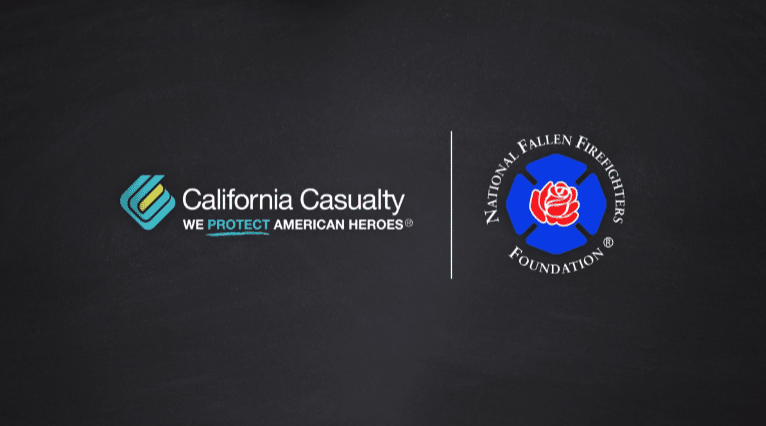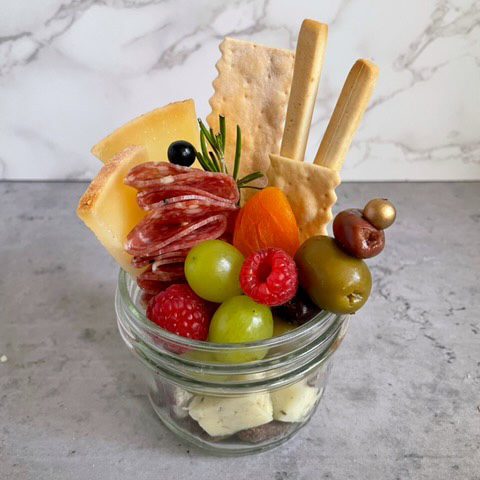


JARcuterie – For Your Next Gathering
Have you heard about Jarcuterie? It’s a party in a jar—or at least the start of it. If you’re planning an elegant Mother’s Day brunch, a great graduation party, or just a fun get-together, you’ll want to know about this latest craze in entertaining.
What is Jarcuterie exactly?
Jarcuterie is a new twist on Charcuterie boards, traditionally a platter of meats and cheese offered as an appetizer or part of a meal. However, instead of a board or platter, Jarcuterie is served in individual jars. The contents don’t even have to be meat and cheese—in fact, the more creative, the better.
Why is Jarcuterie so popular?
It’s pretty to look at, easy to serve, and you can customize it for your guests’ dietary needs. But the main reason for its growth in popularity is due to the pandemic. Rather than touching a platter that others touch too, you can enjoy this socially distant snack safely. And you’ll feel more comfortable as a host that you are doing your part in keeping everyone healthy and safe.
How do I create a Jarcuterie?
The options are endless, which is why a little forethought and planning will make a difference. Do you want savory or sweet? (Yes, dessert Jarcuterie is a thing!) There are no rules, but keep simplicity in mind; generally, Jarcuterie features small finger food and sometimes dips.
Start with a clear container. Popular choices include a mason jar, plastic cup, or small bowl. Choose a size that’s easy to hold because this snack is portable.
Choose a flavor or theme. An Italian-themed Jarcuterie could feature antipasto ingredients such as meats, cheeses, artichoke hearts, cherry tomatoes, and breadsticks. A Mediterranean Jarcuterie could include fresh vegetables with hummus, olives, and feta cheese. A breakfast Jarcuterie might feature mini-muffins, bacon strips, yogurt, and fresh fruit.
Dips go at the bottom. If you include them, dips are best at the base. That way, guests can dip the items into the bottom without getting their fingers messy.
Include a variety of colors, shapes, and textures. This will create a beautiful display that also balances with its ingredients. Use cookie cutters to make fun shapes out of cheese or other items. Roll meats and cheeses together for a festive look. Keep wet snacks away from crunchy ones or assemble the crunchy ones at the last moment so nothing gets soggy.
Keep height in mind. Display food on skewers or cocktail sticks for varying heights. Vary the items on the skewer such as meat, then cheese. Try 1-2 skewers per jar. Add some tall vegetables like celery, which are great for dipping.
Fill in the gaps with tiny treats. Add nuts, dried fruit, pretzels, or other items to fill in the gaps.
Garnish and decorate. Tie the Jarcuterie glass with a bow. Garnish the food with a fresh herb that goes with the flavor palate.
Still not sure what you’re going to make? We scoured the Internet for some popular Jarcuterie recipes. Here are some of our favorites.
Basic Savory Jarcuterie
This basic Jarcuterie recipe combines meat, cheese, crackers, nuts, fruit, pretzels, and more. It’s kid-friendly and they can even help with the preparation!
Flower Garden Jarcuterie
This recipe uses broccoli flowers and radish roses to create a beautiful garden on top of a base of peanuts. Switch out the nuts for some salad dressing dip or hummus for a different sping.
Disney Jarcuterie
This recipe requires a Disney cookie cutter to create Mickey Mouse ears and any other shape for your child’s favorite character. Definitely a dessert version, this Jarcuterie features M&M candy as the base with fresh fruit and cheese displayed on spears.
Colorful Spring Jarcuterie
10 Simple Spring Grazing Table Food Ideas | La Cucina di Kerrs
For those who like to go over the top, this Jarcuterie comes with suggestions on how to dye your vegetables and even spell out the word, spring, with tiny vegetable cutters.
Sweet Ending Jarcuterie
What’s better than a mason jar filled with your favorite sweets? This dessert Jarcuterie pairs mini marshmallows with chocolate drizzled pretzels and strawberries. You can even add your own candied fruit. Pro Tip: use different colors of chocolate for the drizzle to make your Jarcuterie look extra festive!
DIY Charcuterie Bouquets
https://www.areinventedmom.com/charcuterie-bouquet/
This Jarcuterie isn’t in a jar, but its single-serving paper bouquet wrap has the same idea. Deli meat roses pair with strawberries and herbs for a beautiful presentation.
For more JARcuterie ideas, check out our Pinterest Board, “JARcuterie” and be sure to follow us on Pinterest for every other fun idea we find!
This article is furnished by California Casualty, providing auto and home insurance to educators, law enforcement officers, firefighters, and nurses. Get a quote at 1.866.704.8614 or www.calcas.com.

A Parent’s Guide To Preparing for Graduation Day
It seems like just yesterday they were graduating kindergarten. Now your son or daughter is getting ready to graduate high school or college…and you couldn’t be more proud, excited, and maybe just a little bit sad that this chapter is coming to a close.
You’re not the only one feeling this way. (Chances are your son or daughter is too.) Here’s how you can prepare for the big day to help everyone celebrate this milestone to the fullest—and honor all that has happened to bring you here.
1. Embrace the emotions—all of them.
Ask any parent who’s had a child graduate. You can expect a roller coaster of emotions in the weeks before, the day of, and the weeks after. Accept them. Share them, as appropriate, with your child, your partner, and other parents experiencing the same thoughts and feelings. Your role as a parent is changing and it’s okay to feel a little sad or overwhelmed. Your child is probably feeling similarly, in saying goodbye to school friends and transitioning to the next phase. Tell your son or daughter what it was like when you graduated. This may encourage him or her to share their thoughts and feelings with you. Put graduation in perspective and remind yourself that your child is growing up and going on to accomplish big things in the real world. That’s something to celebrate.
2. Mark your calendar.
The last thing you want to do is double book something on graduation day, or schedule things too close to the big day. You want to be sure that you know exactly when and where you need to be. Mark the date and time clearly on the calendar, and include any other important dates leading up to the event. While high schools hold a single commencement, universities typically hold several—small commencement ceremonies by program or major and a large graduation ceremony for all—so make sure you get everything written down. This is a great time to make appointments for haircuts, manicures and pedicures, or any other personal grooming that you desire.
3. For graduation out of town, book a hotel and transportation.
If your student attends school away from home, you’ll want to make sure that you book your hotel, airfare, and rental car well in advance. Hotels are especially important as there are limited rooms near campus and lots of families who will be booking them. The university may have a graduation page on its website with recommendations for hotels. You can also check Airbnb, VRBO, and other rental sites. There are plenty of ways to save money when you travel.
4. Plan who is attending which graduation events.
There is likely a limit to how many guests may attend graduation. That may cause some family drama, especially if you’re dealing with divorce or extended families. Start with a conversation with the graduate-to-be. Discuss their wishes and your own. Know that you can’t please everyone. Make thoughtful decisions, and try to include everyone in some way or another. For example, arrange a watch party for the virtual event while parents attend in person. Then meet up afterward for a celebration. Do you have two students graduating at two different locations? See who can attend so each student has someone there.
Pro Tip: Sometimes schools will have extra tickets available after the initial ticket distribution. If you are looking to seat an additional family member, it’s definitely worth inquiring. Also, if you need special accommodations such as handicapped seating, inquire well in advance.
5. Choose a place for your celebration.
If you are going out, keep in mind that you’ll need to make reservations. Every restaurant within a short drive will likely be filled with families celebrating graduation after the ceremony. Discuss with your student where you may go to celebrate and when so that your son or daughter will also be able to connect with friends if desired. Or you can choose to have a graduation party at home, where you can invite friends and family to come and celebrate all together. Just be sure to make food/dessert arrangements and send out invitations in advance.
6. Set the stage with some great decor.
Celebrate the happy occasion with the neighborhood by posting a Happy Graduation Sign on your front lawn or front door. This helps create a festive mood leading up to the event and also is great for photos. Whether or not the graduation party is at home, add some festive touches like balloons, streamers, and banners. You can even create a photo collage of your child over the years to show how far he or she has come!
7. Choose a graduation gift.
You want something for your graduate to remember the occasion but it doesn’t have to be an expensive gift. Some families use graduation to pass along treasured heirlooms or create meaningful gifts like family trees or photo albums. High school graduates may get a college survival kit; similarly, you can make one for a college graduate moving away from home. Some other popular gifts include luggage (for future travel), savings bonds, laptops or smart devices, and jewelry. You also can find personalized gifts on Etsy and lists of suggested graduation gifts online.
8. Figure out the logistics.
This is one time you absolutely do not want to be late. Are you the one dropping off? Determine how long it will be to get to graduation. Leave plenty of time in the schedule to get to where you need to be. Account for traffic. Allow time for taking photos before you leave. Before you drop off, arrange with your student where you will meet up afterward amidst the post-graduation crowd. It’s going to be busy—and they are all going to be dressed alike!
9. Know what to bring—and not to bring.
Review the rules for graduation. You may not be able to bring food or drink, or even large purses. Is the ceremony outdoors? Bring sunscreen and a hat, or an umbrella and raincoat if necessary. Wear comfortable shoes; there will probably be a lot of walking. Don’t forget to pack that extra pack of tissues or a handkerchief to catch all of those tears of joy!
10. Enjoy the moment.
This is the day you’ve all been waiting for. Celebrate it with pride, and enjoy every moment—even the ones that may not be picture perfect. Your child has reached an incredible milestone and you were a large part in helping them take this step toward their future. Reminisce, but try and keep all of the baby photos and embarrassing stories packed away until you get home. Your child will appreciate it. Go ahead and make some memories that you’ll be able to cherish for years to come. Don’t forget to take pictures.
Happy graduation from all of us at California Casualty!
This article is furnished by California Casualty, providing auto and home insurance to educators, law enforcement officers, firefighters, and nurses. Get a quote at 1.866.704.8614 or www.calcas.com.

Improving Listening Skills for You and Your Students
In our world of constant communication, it’s easy to be distracted from really listening to someone. Yet good listening skills take us far—in the classroom and beyond. Good listening skills build relationships and resolve conflicts. They help students learn, and help all of us make fewer mistakes and waste less time.
As teachers, we understand that listening is an important soft skill, but we may not teach it. Here’s why you should, along with some guidance on how to improve listening skills for you and your students.
Active vs. Passive Listening
It’s easy to be a passive listener. That’s listening as we multitask. As passive listeners, we divide our attention between listening and doing something else. That does not benefit us as teachers or students. Rather, active listening – focusing all of our attention on receiving and processing information – helps us to fully understand what is being communicated.
Active listening helps students:
-
- Follow directions
- Understand expectations
- Spend more time on task
- Connect to content and increase understanding
Active listening helps educators:
-
- Better understand student needs
- Provide meaningful feedback
- More fully engage students
- Communicate well with parents, peers, and the administration
How to Teach Active Listening
It feels good when someone is actively listening to you. Demonstrate that to your students by modeling two conversations – one with active listening and one with passive. Discuss the importance of active listening. Then, walk them through the process of how to be an active listener together.
To be an active listener you need to…
1. Focus.
It’s easy to be distracted by the things in our environment, from our phones and devices to other people and happenings around us. To be a really good listener, you have to focus solely on the person talking to you.
Don’t multi-task, look around, or think about things you need to do.
Do give the speaker your undivided attention. Put aside your phone, papers, or any potential distractions. Face the speaker and maintain eye contact. Be present in the moment.
2. Receive.
The best listeners are those who are receptive to new information. You need to be ready to receive a message in order to listen. Importantly, good listeners are not critical. They create a safe environment where others may share their thoughts.
Don’t be judgmental. Don’t engage in a conversation if you’re not ready to listen.
Let go of your opinions during the conversation. Listening does not mean you agree with the message, only that you respect another’s right to express it.
3. Visualize.
As the saying goes, a picture is worth a thousand words. That’s why it’s helpful to visualize what the other person is saying. In addition, knowing the speaker’s emotional state will help you more fully understand what he or she is trying to communicate.
Don’t assume you know what the speaker is saying or feeling.
Do listen to the words and picture what the speaker is saying. Pay attention to the speaker’s nonverbal cues, from body language to the tone of his or her voice. Try to feel what the speaker is feeling.
4. Wait.
It’s tempting to interrupt a speaker and impose your thoughts or solutions right away—especially if he or she says something that relates to your life. It’s easy to get sidetracked but that’s not good listening. We all think and talk at different rates. Let the other person have a chance to speak.
Don’t interrupt or jump in with your own thoughts or questions. Don’t finish the other person’s sentences. Don’t sidetrack the conversation by starting a new, related or unrelated conversation.
Be patient. At first, it might be hard to simply wait. With practice, it will get easier.
5. Understand.
Eventually, you’ll want to ask a question or two. Questions show that you are listening and that you want to understand what the speaker is saying. Your goal is empathy—to feel what the speaker is feeling. Empathy creates a connection like nothing else does.
Don’t spend the time planning what to say next. It will distract you from what’s being said.
Do wait until the speaker pauses to ask questions to clarify the message. You can say something along the lines of “Can we back up for a moment? I have a question about …”
6. Respond.
You do not have to be perfectly silent or still in the listening role. Good listeners consistently provide feedback whether it’s a word of confirmation or a nod of agreement.
Don’t just sit there or zone out, even if you’re bored.
Do nod and show your understanding through appropriate facial expressions. Interject with a well-timed “hmm” or another simple statement that confirms the message the speaker is sharing.
7. Summarize
You will want to ensure that you correctly understood the message. At the end of the conversation, try telling the speaker what you heard.
Don’t make a long summary statement. The purpose is not to capture every detail but merely the essence of the message.
Do let the speaker know that this is what you understood and ask for clarification if it is wrong. If there’s follow-up to the conversation needed, now is the time to mention the next steps.
Practicing Active Listening
Active listening takes practice. Model good listening skills and call attention to them as you are doing them. Involve students in the process regularly with active listening activities. Examples include:
-
- Partner conversations
- Journal entries following a lesson or other presentation
- Listen and draw a story
- Outdoor sound scavenger hunt
- Mindful listening meditations
This article is furnished by California Casualty, providing auto and home insurance to educators, law enforcement officers, firefighters, and nurses. Get a quote at 1.866.704.8614 or www.calcas.com.

Quick & Easy Spring DIY Room Makeovers
Have you spent years dreaming about a home makeover? Or find yourself sitting on social media watching others DIY thinking ‘why can’t I do that?’ You CAN! Believe it or not, you don’t have to be a design expert to create a cozy corner, a relaxing vibe, or a stylish space in your home. Here are some quick and easy DIY room makeovers for your home that you can do this spring to give your space a nice little refreshing update- on a budget.
Bedroom
– Choose a color scheme. Pick two main colors and use them to choose varying textures and patterns which will add visual interest. This will help tie together the look of your room, whether it’s a bedroom or other room in your home. Best colors for bedrooms are cool, relaxing tones. Think shades of blue and muted greens.
– Showcase your headboard. The bed is the focal point in your room. Give it a little drama with the right headboard. For an easy fix, use a curtain behind your bed as the headboard. Make your own fabric headboard with material that matches your color scheme.
– Remember the fifth wall. Who said ceilings need to be white? In bedrooms, we spend our share of the time staring at the ceiling. Paint the ceiling a color, and see how it transforms the space.
– Hang drapes from floor to ceiling. Go a few inches above your window to add height, and have the drapes go down to the floor for an elegant feel.
– Get fancy with hardware: Chances are that your nightstands and dressers have traditional knobs. Change them out for tassel hardware or other fancy options.
Living Room
– Create a gallery wall. Choose the photos that represent wonderful moments in your life, and images of the people who are most important to you. For a cohesive look, choose the same color frames. Make it a statement wall by painting it a color that’s different from the other three walls.
– Include a hobby piece. Do you love to travel? Perhaps you play guitar. See if you can incorporate some of your favorite past times in the décor. A surfboard shelf, framed albums, a world map, or a guitar hung on your wall not only is a decoration, but a reminder of your happy place.
– Wallpaper a wall. Removable wallpaper lets us change our style without the long-term commitment. Choose a vibrant pattern in your color scheme for one focus wall. The wallpaper becomes the art and sets the tone for the space.
– Add wainscoting to your wall. This decorative trim transforms a room with its elegant accent pieces. You can even use the trim as a guide and paint the wall different colors above and below.
– Conceal the clutter. Use baskets or decorative boxes to store magazines, electronics, and loose items that you use regularly. Place them on a bookshelf to keep them out of the way.
– Add an area rug. It doesn’t matter if you have a carpet already in your living room. You can still add an area rug on top. Choose a pattern in your color scheme and it becomes artwork for your floor.
Kitchen
– Add a backsplash. It creates a beautiful focal point behind the stove and in other places above the counters. There are so many options available, from glass mosaics to tile to peel-and-stick. You can find online tutorials on how to install a backsplash from the major retailers and home improvement sites.
– Upscale your knobs and handles. Give your drawers and your cabinets a fresh look by changing out the knobs and handles. It’s a lot easier than painting cabinets, though you can do that, too.
– Install a pot rack on your wall. It’s an easy way to display your cookware while freeing space in your cabinets for other utensils.
– Add under cabinet lighting. You don’t need to be an electrician to install this type of lighting, which is self-adhesive and comes in strips that can be trimmed to fit your space. It plugs into a standard outlet and some models come with dimmer switches.
Bathroom
– Upgrade that mirror. You don’t have to spend a fortune to switch out your plain bathroom mirror for one that will be a focal piece. You can add your own frame. You can also reimagine the space with a find from the local thrift shop. Don’t hesitate to add paint for that special look.
– Paint your bathroom vanity. A little paint can transform an old vanity into a beautiful piece. Switch out the knobs and drawer hardware for an even newer look.
– Change out your towel rack. You can find many towel racks at your local home improvement store. If you have the time, consider making your own to highlight your own personal style.
Not sure where to start?
– Create a mood board. Collect images of items that you like. You can do this on Pinterest or on a PowerPoint or Word document. You can even do it old school and paste the pictures on a board.
– Find your color scheme in a favorite piece of art. See if those colors will work for your room, and of course, make sure that the art piece is part of the décor.
– Move furniture around. Take out a piece of furniture. See what works and what doesn’t for your space.
For more spring DIY décor inspo, check out our Pinterest Board- Staycation DIYs! Be sure to follow us for every new DIY we discover.
Happy decorating! 🙂
This article is furnished by California Casualty, providing auto and home insurance to educators, law enforcement officers, firefighters, and nurses. Get a quote at 1.866.704.8614 or www.calcas.com.




